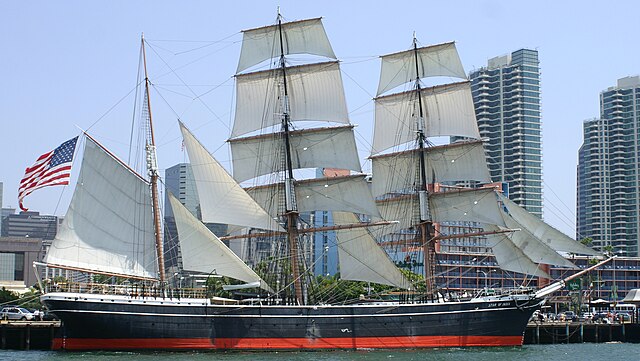Star of India is an iron-hulled sailing ship, built in 1863 in Ramsey, Isle of Man as the full-rigged ship Euterpe. After a career sailing from Great Britain to India and New Zealand, she was renamed, re-rigged as a barque, and became a salmon hauler on the Alaska to California route. Retired in 1926, she was restored as a seaworthy museum ship in 1962–3 and home-ported at the Maritime Museum of San Diego in San Diego, California. She is the oldest ship still sailing regularly and also the oldest iron-hulled merchant ship still afloat. The ship is both a California Historical Landmark and United States National Historic Landmark.
Star of India docked in San Diego
Euterpe at Port Chalmers, the port of Dunedin, in 1883
Star of India docked in San Diego
Star of India stern and Taffrail
Iron-hulled sailing ships represented the final evolution of sailing ships at the end of the age of sail. They were built to carry bulk cargo for long distances in the nineteenth and early twentieth centuries. They were the largest of merchant sailing ships, with three to five masts and square sails, as well as other sail plans. They carried lumber, guano, grain or ore between continents. Later examples had steel hulls. They are sometimes referred to as "windjammers" or "tall ships". Several survive, variously operating as school ships, museum ships, restaurant ships, and cruise ships.
Four-masted, iron-hulled barque Herzogin Cecilie
Diagram of rigging and sails on a full-rigged ship, ca. 1905
Crew of the ship Garthsnaid at sea, ca. 1920, securing a section of the foresail.
The largest sailing ship to survive, the four-masted barque Moshulu at Philadelphia, Pennsylvania, United States








